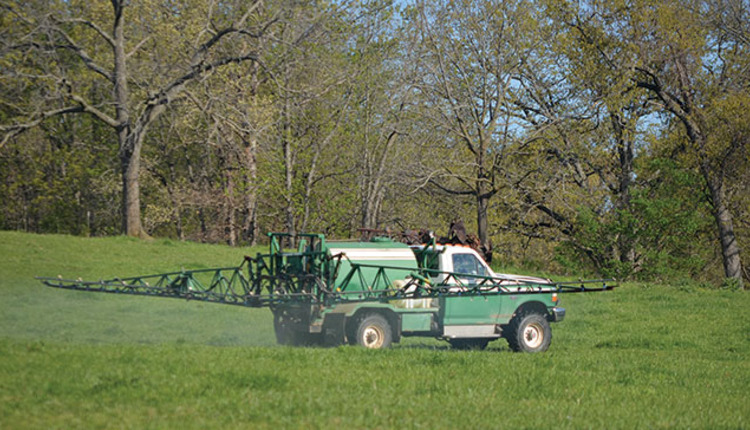
Another characteristic, that adds to the grass’s popularity, includes its ability to produce forage in a wide range of soil and climatic conditions. The species is well adapted to shallow, droughty ridge soil and survives on wet, poorly drained soil as well. However, if fescue is in standing water for any length of time, it will die.
Fescue could be a “wonder grass” except for a small fungus that grows inside its cells. The fungus is an endophyte — endo meaning “in” and phyte meaning “plant.” This fungus produces toxic, ergot alkaloids, which cost the beef cattle industry well over $1 billion annually.
“Losses stem from decreased feed intake, lower weight gains, less milk production, poor offspring survival, and poor reproductive performance by both bulls and cows,” said Raymond Stegeman, D.V.M., Osage Veterinary Clinic, St. Thomas, Mo.
“Cattle with fescue toxicosis have high internal body temperatures, high respiration rates, and loss of blood flow. They retain a rough hair coat, demonstrate unthrifty appearance, and salivate excessively. Reduced blood flow often leads to fescue foot that results in lameness and in extreme cases, loss of a hoof.”
Renovation alternative
Fortunately, there are ways to manage fescue pastures in a manner to avoid toxicity problems. If total pasture renovation is feasible, it can be replanted to endophyte-free or novel fescue varieties.
“Disadvantages of pasture renovation is grazing loss during the establishment period and cost,” said Scott Flynn, field scientist with Dow AgroSciences. “Seeding rates of endophyte-free or novel fescues is 20 to 25 pounds per acre at a cost of $3 to $4 per pound. Total renovation costs, including machinery operating and labor expenses, is between $400 and $600 per acre.
“Toxins concentrate in fescue seedheads at a rate of three to six times higher than in leaves,” Flynn added. “Peak concentrations occur when seeds are in the dough stage, which is also when they are most palatable. Reducing or eliminating seedheads can help decrease incidence and severity of fescue toxicosis.”
“Fescue seedhead removal by
shredding is effective, but it is hard to stay on schedule,” said Jason Locke, manager of the West Ranch for Circle A Angus Ranch, Stockton, Mo. “Shredding is also expensive, costing approximately $15 per acre for one mowing. If not mowed at the proper time, seedheads may still emerge and require a second mowing.”
A relatively new method of seedhead suppression is spraying fescue with Chaparral specialty herbicide. Chaparral contains 0.62 pound of potassium salt of aminopyralid active ingredient and 0.0945 pound of metsulfuron methyl per pound of product. It is a broad-spectrum weed and brush herbicide labeled for use on range and pastureland.
The recommended application rate of Chaparral for seedhead suppression and weed control is 2 ounces of product per acre at an estimated cost of $12 per acre. Application costs vary, depending on type of spray equipment and the applicator.
“Both day length and temperature can affect seedhead emergence in tall fescue,” said Pat Burch, field scientist with Dow AgroSciences. “Day length triggers formation of the seedhead, and temperature influences rate of growth and development. It is best to make an application of Chaparral for fescue seedhead suppression during the period from approximately three weeks prior to seedhead emergence until the grass is in the boot stage.
“Research across the fescue belt shows that an early spring application of Chaparral prevents most tall fescue plants from developing seedheads,” explained Burch. “In addition, winter annual weeds and early season broadleaves, such as buttercup; poison hemlock; biennial musk, bull and plumeless thistle; wild carrot; and common mullein are controlled. Producers can also obtain pre-emergent control of later emerging susceptible weeds such as horsenettle, ragweed, and pigweeds.”

Sixty to 80 percent of tall fescue growth is stems and seedheads. As a plant matures toward heading, flowering, and seed formation, its growth pattern changes from producing digestible leaves to producing indigestible hard stems.
At each progressive growth stage, the digestible part of the plant tissue declines rapidly and nutrient content drops as well. Digestibility and nutrient content are important because they greatly affect animal performance. Suppressing fescue seedheads keep plants in a vegetative stage of growth, which helps maintain forage quality.
“Spraying fescue too early causes the plants to yellow resulting in a brief pause in forage production,” said Glen Aiken, USDA-ARS research scientist at the Forage-Animal Production Research Unit in Lexington, Ky. “Weak fescue stands and poor fertility may result in more intense yellowing.
“Cattle prefer green, palatable grass over yellowed fescue, but they might graze it to a small degree if there is an insufficient amount of green forage available,” added Aiken. “It is best to suppress seedheads with Chaparral in a pasture rotation system where cattle can be moved to an unsprayed pasture. In a continuous grazing system, interruption of grazing can be avoided by spraying only a portion of a pasture.”
Chaparral offers another option for controlling fescue toxicosis where it fits the overall ranch management plan. Always read and follow the product label when using any pesticide.
This article appeared in the April/May 2017 issue of Hay & Forage Grower on pages 32 and 33.
Not a subscriber? Click to get the print magazine.

